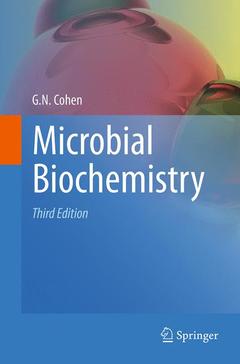Microbial Biochemistry (3rd Ed., Softcover reprint of the original 3rd ed. 2014)
Auteur : Cohen G. N.

Foreword
Introduction
1. Bacterial growth
2. The outer membrane of Gram-negative bacteria and the cytoplasmic membrane
3. Peptidoglycan synthesis and cell division
4. Cellular permeability
5. Allosteric enzymes
6. Glycolysis, gluconeogenesis, glycogen and cellulose biosynthesis
7. The pentose phosphate and Entner-Doudoroff pathways
8. The tricarboxylic acid cycle and the glyoxylate bypass
9. ATP-generating processes. Respiration and Fermentation
10. Biosynthesis of lipids
11. Iron-sulfur proteins
12. The Archaea
13. Methanogens and methylotrophs
14. Enzyme induction in catabolic systems
15. Transcription. RNA polymerase
16. Negative regulation
17. Enzyme repression in anabolic pathways
18. Positive regulation
19. The Ribosomes, Translation, Chaperones and Chaperonins
20. The genetic code, the transfer RNAs and the aminoacyl-tRNA-synthetases
21. Attenuation
22. Regulation by RNAs and Riboswitches
23. The biological fixation of nitrogen
24. How biosynthetic pathways have been established
25. The aspartic acid family of amino acids
26. Regulation of the biosynthesis of the amino acids of the aspartic acid family in Enterobacteriaceae
27. Other patterns of regulation of the synthesis of amino acids of the aspartate family
28. Biosynthesis of the amino acids of the glutamic acid family and its regulation
29. Biosynthesis of amino acids derived from phosphoglyceric acid and pyruvic acid
30. Selenocysteine and selenoproteins
31. Biosynthesis of aromatic amino acids and its regulation
32. The biosynthesis of histidine and its regulation
33. The biosynthesis of nucleotides
34. The biosynthesis of deoxyribonucleotides
35. Biosynthesis of some water-soluble vitamins and of their coenzyme forms
36. Biosynthesis of carotene, vitamin A, sterols, ubiquinones and menaquinones
37. Biosynthesis of the tetrapyrrole ring system
38. Biosynthesis of cobalamins including vitamin B12
39. Interactions between proteins and DNA
40. Evolution of biosynthetic pathways
Abbreviations
Subject Index.
Third edition of this authoritative work on microbial biochemistry
Describes a multitude of biosynthetic pathways in great detail
Provides the reader with a large collection of detailed descriptions of cellular processes
Date de parution : 09-2016
Ouvrage de 611 p.
15.5x23.5 cm
Disponible chez l'éditeur (délai d'approvisionnement : 15 jours).
Prix indicatif 158,24 €
Ajouter au panierDate de parution : 08-2014
Ouvrage de 611 p.
15.5x23.5 cm
Disponible chez l'éditeur (délai d'approvisionnement : 15 jours).
Prix indicatif 158,24 €
Ajouter au panier


